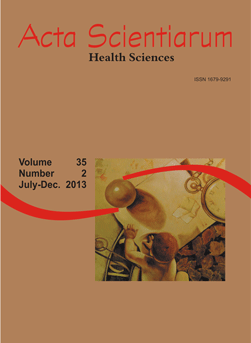<b>Chlorophyllin in the intra-uterine development of mice exposed or not to cyclophosphamide</b> - doi: 10.4025/actascihealthsci.v35i2.12470
Abstract
Chlorophyllin, a sodium-copper salt synthesized from chlorophyll, has already proved to have anticlastogenic, antimutagenic and anticarcinogenic activity, however few are the studies in the teratogenicity area. The present study evaluated the effects of chlorophyllin in intra-uterine development of mice exposed or not to cyclophosphamide. Pregnant females were divided into 8 groups of 15 animals each, G01 - PBS (0.1 mL 10.0-1 g) orally; G02 – cyclophosphamide (20.0 mg kg-1) i.p.; G03, G04 and G05 - chlorophyllin at concentrations of (5.0, 10.0 and 15.0 mg kg-1) orally; G06, G07 and G08 (5.0, 10.0 and 15.0 mg kg-1) orally, of chlorophyllin, respectively, and (20.0 mg kg-1) i.p. of cyclophosphamide. In the 18th day the females were submitted to laparotomy and females and fetuses analyzed. The results showed that the chlorophyllin was not effective in protecting the reproductive parameters as well as teratogenicity. Finally, it was observed that the presence of chlorophyllin increased the frequency of some malformations when combined with cyclophosphamide. However, it was not teratogenic and not embryo lethal in this experimental design.
Downloads
DECLARATION OF ORIGINALITY AND COPYRIGHTS
I Declare that current article is original and has not been submitted for publication, in part or in whole, to any other national or international journal.
The copyrights belong exclusively to the authors. Published content is licensed under Creative Commons Attribution 4.0 (CC BY 4.0) guidelines, which allows sharing (copy and distribution of the material in any medium or format) and adaptation (remix, transform, and build upon the material) for any purpose, even commercially, under the terms of attribution.
Read this link for further information on how to use CC BY 4.0 properly.























5.png)







